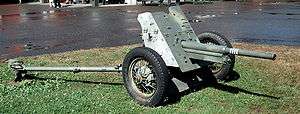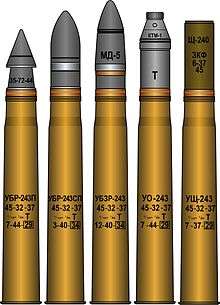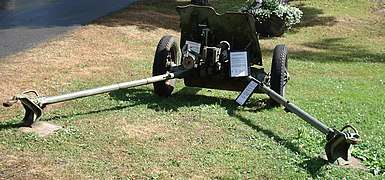45 mm anti-tank gun M1937 (53-K)
| 45 mm anti-tank gun model 1937 (53-K) | |
|---|---|
 45 mm anti-tank gun M1937, displayed in Finnish Tank Museum in Parola. | |
| Type | Anti-tank gun |
| Place of origin | USSR |
| Production history | |
| Produced | 1937-1943 |
| No. built | 37,354 |
| Specifications | |
| Weight |
combat: 560 kg (1,234 lbs) travel: 1,200 kg (2,645 lbs) |
| Length | 6.4 m (21 ft 0 in) |
| Barrel length | 2.07 m (6 ft 9 in) 46 calibers[1] |
|
| |
| Shell | Fixed QF 45x310 mm. R |
| Caliber | 45 mm (1.77 in) |
| Breech | Semi-automatic vertical sliding-wedge |
| Recoil | Hydro-spring |
| Carriage | Split-trail |
| Elevation | -8° to 25° |
| Traverse | 60°[1] |
| Rate of fire | 15-20 rpm |
| Muzzle velocity | 760 m/s (2,493 ft/s) |
| Maximum firing range | 4.4 km (2.73 mi)[1] |

The 45 mm anti-tank gun model 1937 (factory designation 53-K) was a light quick-firing anti-tank gun used in the first stage of the German-Soviet War. It was created by Soviet artillery designer M.N. Loginov after the arrest and execution of former designer V. von Behring. Due to insufficient armor penetration it was replaced in service by the long-barreled 45 mm anti-tank gun M1942 (M-42).
History
The gun bearing factory designation 53-K (Cyrillic 53-К) was an improved version of the 45 mm anti-tank gun M1932 (19-K) using modern ammunition. Other improvements comprised semi-automatic breech, sight, firing button, suspension, reliable shield mount, and movable part re-balancing. The sum of evolutionary improvements resulted in a significantly different design to justify the new factory code (53-K).[2]
The design was finalized on 7 November 1936 and the resulting light semi-automatic anti-tank gun was adopted for Red Army service in early 1937, and was thus known as "45 mm anti-tank gun M1937" (Russian: 45-мм противотанковая пушка образца 1937 года). These guns were also supplied to Republican Spain and were used by the International Brigades in the British Anti-tank Battery of the XV Brigade, who served from the Battle of Brunete onwards. Richard Baxell notes that the gun in Spain "was effective against even heavy tanks at distances of up to three kilometers." [3] The guns also saw service in first stage of the German-Soviet War, but their anti-armor capabilities allowed them to fight successfully only with German light tanks and armored personnel carriers. Early models of the Panzer III and Panzer IV could also be knocked out at close range, but this put Soviet artillerymen in greater danger. Due to these circumstances, model 1937 guns were replaced with an all-new design, the more powerful model 1942. The mass production of outdated model 1937 guns was stopped in 1943. The total number of guns produced was 37,354. The German designation for captured M1937 guns was the 4.5 cm Pak 184/1(r).[4]
Two such guns were employed as an anti-tank platoon, organic to each rifle battalion. Additionally twelve guns were in anti-tank battalions of each rifle division. It was also used by separate anti-tank regiments (4-5 batteries of 4 guns each).
Ammunition
Ammunition types:
- B-240/BR-240 - armor-piercing
- Armor-piercing chemical
- UBR-240P - armor-piercing composite rigid
- UBR-243P – sub-caliber armor-piercing
- UBR-243SP – armor piercing
- UBZR-243 – armor piercing incendiary
- UO-243 – fragmentation
- UssH-243 – shrapnel
- Smoke
Performance
| Penetration[5] | |||||
| Type | 100 m (110 yd) | 500 m (550 yd) | 1,000 m (1,100 yd) | 1,500 m (1,600 yd) | 2,000 m (2,200 yd) |
| APHE | 61 mm (2.4 in) | 46 mm (1.8 in) | 32 mm (1.3 in) | 22 mm (0.87 in) | 15 mm (0.59 in) |
| APBC-HE | 59 mm (2.3 in) | 45 mm (1.8 in) | 35 mm (1.4 in) | 29 mm (1.1 in) | 26 mm (1.0 in) |
| APCR | 94 mm (3.7 in) | 64 mm (2.5 in) | 40 mm (1.6 in) | - | - |
Photo Gallery
References
- 1 2 3 Chamberlain, Peter (1974). Anti-tank weapons. Gander, Terry. New York: Arco Pub. Co. p. 4. ISBN 0668036079. OCLC 1299755.
- ↑ Сорокопятка
- ↑ Richard Baxell Unlikely Warriors: the British in the Spanish Civil War and the Struggle against Fascism (London: Aurum Press 2012) p223
- ↑ Chamberlain, Peter (1974). Anti-tank weapons. Gander, Terry. New York: Arco Pub. Co. p. 54. ISBN 0668036079. OCLC 1299755.
- ↑ Bird, Lorrin; Lingston, Robert (2001). World War II Ballistics: Armor and Gunnery. Albany, NY USA: Overmatch Press. OCLC 71143143.
- Shunkov V. N. - The Weapons of the Red Army, Mn. Harvest, 1999 (Шунков В. Н. - Оружие Красной Армии. — Мн.: Харвест, 1999.) ISBN 985-433-469-4
- Koll, Christian (2009). Soviet Cannon - A Comprehensive Study of Soviet Arms and Ammunition in Calibres 12.7mm to 57mm. Austria: Koll. p. 422. ISBN 978-3-200-01445-9.
External links
| Wikimedia Commons has media related to M-37 45 mm anti-tank gun. |
- 45 mm anti-tank gun model 1937 at rustrana.ru (in Russian)
- 45 mm anti-tank gun model 1937 manual at xlt.narod.ru (in Russian)




